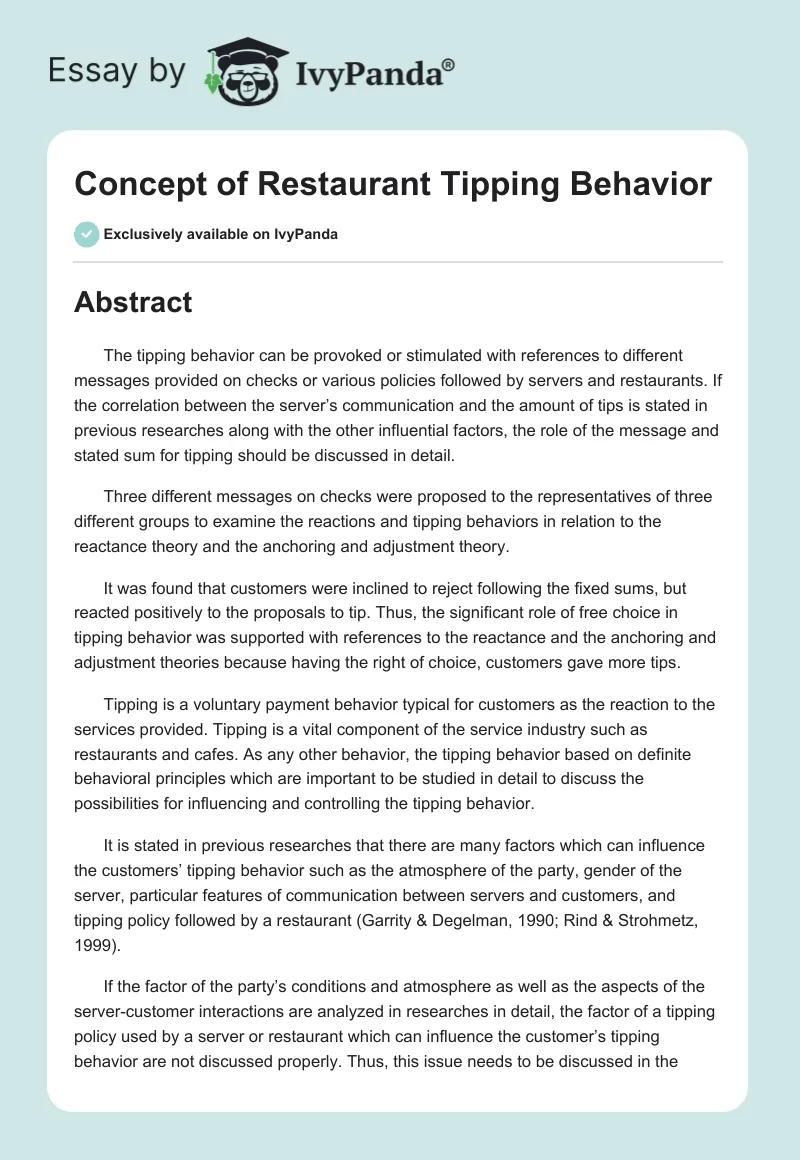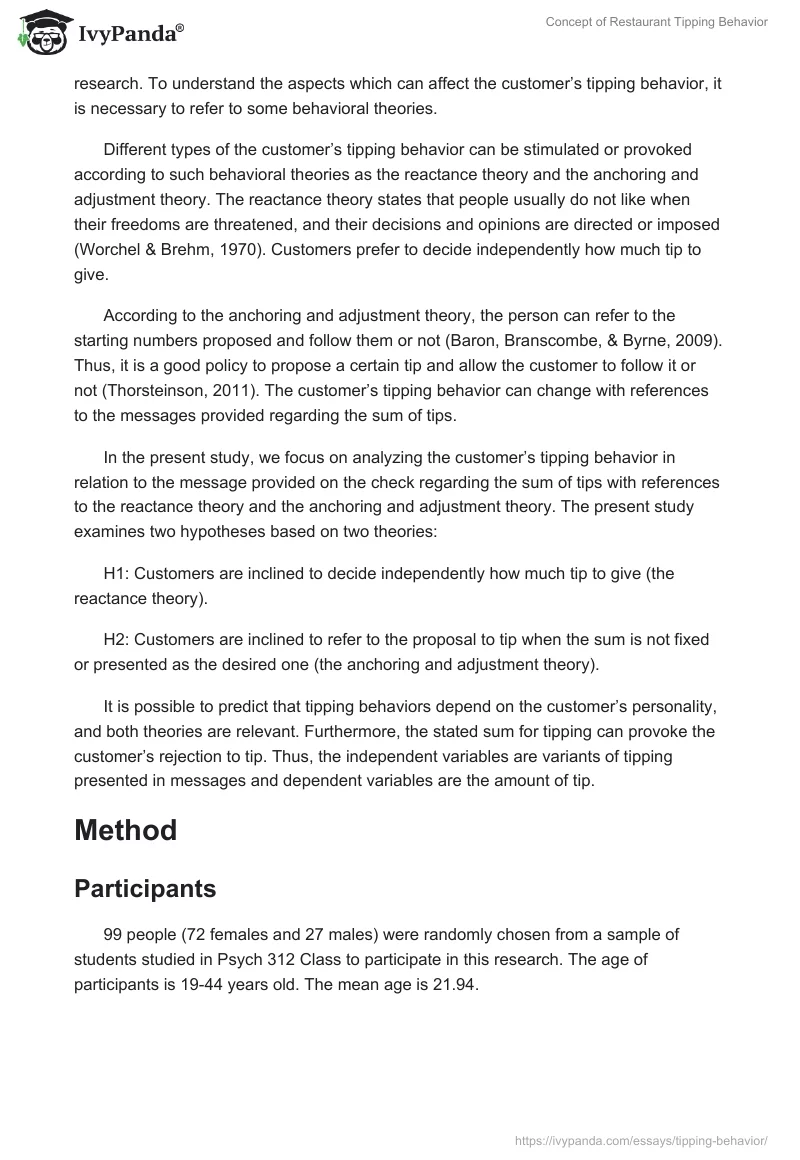Abstract
The tipping behavior can be provoked or stimulated with references to different messages provided on checks or various policies followed by servers and restaurants. If the correlation between the server’s communication and the amount of tips is stated in previous researches along with the other influential factors, the role of the message and stated sum for tipping should be discussed in detail.
Three different messages on checks were proposed to the representatives of three different groups to examine the reactions and tipping behaviors in relation to the reactance theory and the anchoring and adjustment theory.
It was found that customers were inclined to reject following the fixed sums, but reacted positively to the proposals to tip. Thus, the significant role of free choice in tipping behavior was supported with references to the reactance and the anchoring and adjustment theories because having the right of choice, customers gave more tips.
Tipping is a voluntary payment behavior typical for customers as the reaction to the services provided. Tipping is a vital component of the service industry such as restaurants and cafes. As any other behavior, the tipping behavior based on definite behavioral principles which are important to be studied in detail to discuss the possibilities for influencing and controlling the tipping behavior.
It is stated in previous researches that there are many factors which can influence the customers’ tipping behavior such as the atmosphere of the party, gender of the server, particular features of communication between servers and customers, and tipping policy followed by a restaurant (Garrity & Degelman, 1990; Rind & Strohmetz, 1999).
If the factor of the party’s conditions and atmosphere as well as the aspects of the server-customer interactions are analyzed in researches in detail, the factor of a tipping policy used by a server or restaurant which can influence the customer’s tipping behavior are not discussed properly. Thus, this issue needs to be discussed in the research. To understand the aspects which can affect the customer’s tipping behavior, it is necessary to refer to some behavioral theories.
Different types of the customer’s tipping behavior can be stimulated or provoked according to such behavioral theories as the reactance theory and the anchoring and adjustment theory. The reactance theory states that people usually do not like when their freedoms are threatened, and their decisions and opinions are directed or imposed (Worchel & Brehm, 1970). Customers prefer to decide independently how much tip to give.
According to the anchoring and adjustment theory, the person can refer to the starting numbers proposed and follow them or not (Baron, Branscombe, & Byrne, 2009). Thus, it is a good policy to propose a certain tip and allow the customer to follow it or not (Thorsteinson, 2011). The customer’s tipping behavior can change with references to the messages provided regarding the sum of tips.
In the present study, we focus on analyzing the customer’s tipping behavior in relation to the message provided on the check regarding the sum of tips with references to the reactance theory and the anchoring and adjustment theory. The present study examines two hypotheses based on two theories:
H1: Customers are inclined to decide independently how much tip to give (the reactance theory).
H2: Customers are inclined to refer to the proposal to tip when the sum is not fixed or presented as the desired one (the anchoring and adjustment theory).
It is possible to predict that tipping behaviors depend on the customer’s personality, and both theories are relevant. Furthermore, the stated sum for tipping can provoke the customer’s rejection to tip. Thus, the independent variables are variants of tipping presented in messages and dependent variables are the amount of tip.
Method
Participants
99 people (72 females and 27 males) were randomly chosen from a sample of students studied in Psych 312 Class to participate in this research. The age of participants is 19-44 years old. The mean age is 21.94.
Materials
The material used in this experiment was a video about the Australian restaurant, a scenario explaining a hypothetical experience at a restaurant, a short questionnaire about experience, and 3 different types of checks from the restaurant with a hypothetical cost. The first check included a total price and a tip line. The second type of check included a total price, a tip line, and a sentence saying that the tipping is appreciated. The third type of check included a total price, a tip line, and a comment suggesting 25% tip.
Design
This experiment is a multi-level between subjects design. The design of this experiment included three conditions which are one control group and two experimental groups (to analyze the behaviors according to two different theories). The participants were randomly assigned to one of the groups. The independent variable is the check type provided, and the dependent variable is amount of tip. Each type of check was one level of the independent variable, there were three levels.
Procedure
Participants watched a short video about the Australian restaurant. Then they were given a scenario, a short questionnaire about the experience, and one of the three different types of checks according to the group.
The participants from the first group (the reactance theory) were given the check with the fixed 25% tip, the participants from the second group (the anchoring and adjustment theory) were given the check with the message, and the control group was given the check with an empty tip line. Participants answered the questions (e.g. “Would you like to return to this restaurant?”, “Would you suggest this restaurant to your friend?”). Finally, the participants were told to write how much they would tip. Age and gender were recorded.
Results
The results of this experiment were calculated by SPSS computer system. The one-way ANOVA results showed that the effect of the message was statistically significant – F(2.96)= 4.097, P=0.2. The post hoc test results showed that the tipping behavior of the second group and the control group did not differ significantly.
Moreover, the difference in tip for the first (reactance) group and for the second (anchoring) group was significant. The mean tip for the reactance group was lower than for the anchoring group alone and for the control group alone. Thus, the participants of the reactance group rejected the proposed tip and lowered it when the representatives of the anchoring group acted similarly to those ones from the control (independent) group and provided the adequate tip.
Discussion
The hypotheses were supported by the results because the tipping behavior of participants depended significantly on the message provided in the check with the purpose to provoke or impose the definite customer’s reaction. The results showed that the reactance theory and the anchoring and adjustment theory are closely connected with the style of the customer’s tipping.
We can conclude that people are more likely to tip more if they are given some kind of reminder, a proposal, or a personal note from the waiter on the check. However, the positive attitude of the customers is challenged when the fixed sum of the tip is provided in the check. Thus, customers are inclined to have the freedom of choice in relation to how much to tip.
The potential confounds of this experiment can be the customers’ age. Young people in comparison with to older people can have very different incomes. Moreover, young people are more likely to tip less than older people. According to this confound, further experiment can be conducted on the issue of age affecting the tipping behavior.
References
Baron, R., Branscombe, N. & Byrne, D. (2009). Social psychology. USA: Pearson/Allyn & Bacon.
Garrity, K. & Degelman, D. (1990). Effect of server introduction on restaurant tipping. Journal of Applied Social Psychology, 20(2), 168-172.
Rind, B., & Strohmetz, D. (1999). Effect on restaurant tipping of a helpful message written on the back of customers’ checks. Journal of Applied Social Psychology, 29(1), 139-144.
Thorsteinson, T. (2011). Initiating salary discussions with an extreme request: Achoring effects on initial salary offers. Journal of Applied Social Psychology, 41(7), 1774–1792.
Worchel, S. & Brehm, J. (1970). Effect of threats to attitudinal freedom as a function of agreement with the communicator. Journal of Personality and Social Psychology, 14(1), 18-22.


